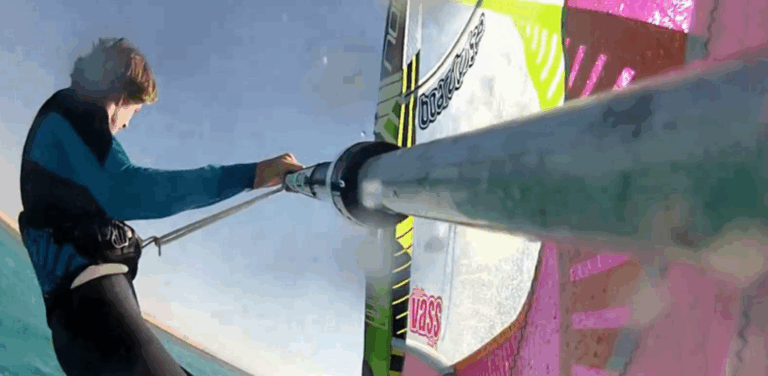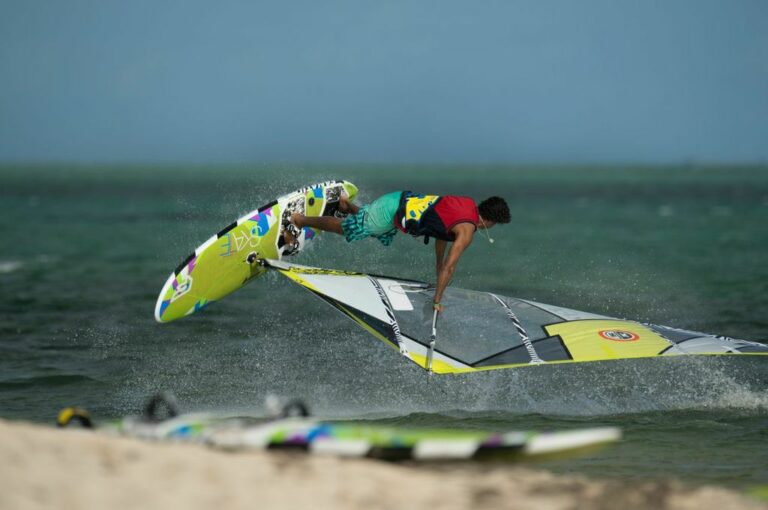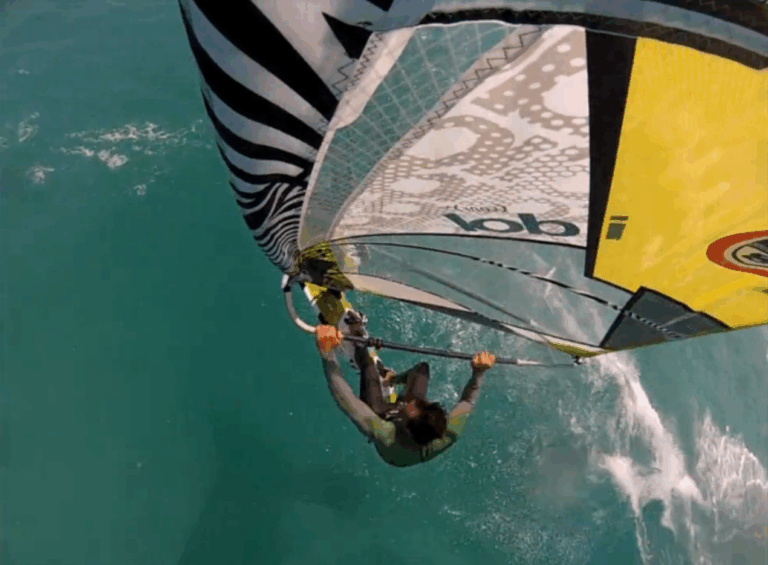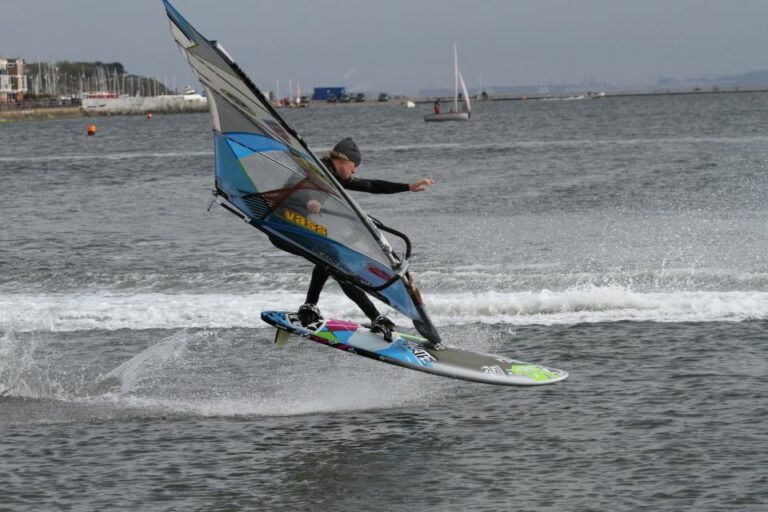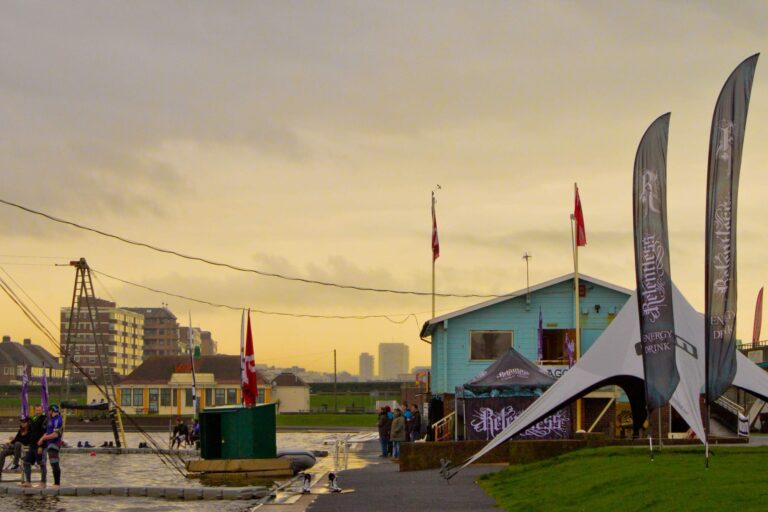
What are the top moves being performed at the moment: in UK competitions, in the EFPT and in PWA?
COLIN DIXON: Air moves are the key, doing the whole move in the air is what’s winning! The higher you go and more you rotate the better.
ADAM SIMS: In the UK competitions I think we have seen air funnel into funnel, burner funnels, culos, skopus and regular konos (maybe some of those moves have only been done in tow-in). On the EFPT it is the same as the PWA pretty much, double and triple moves, push loops, etc… Maybe the PWA it is perhaps a tiny bit higher when Gollito gets in the zone in Fuerte, ridiculous one handed air chachoos, we’ve seen double forwards from Koester there before, I’ve seen Steven VB and Martin VO doing doubles and air chachoos outside of heats.
JOHN PALMER: UK Comps – Kono’s, Culos, Burners (By the looks of the footage I’ve seen of Max I’m sure it’ll be super high this year!) EFPT isn’t far off the PWA in standard. Best moves in the PWA at the moment for me are Kabikuchis, and Gollitos massive double air flakas and double burners.
MAX ROWE: The top moves at the moment are mostly combinations such as burner into burner or Culo into Spock. The PWA format allows more top moves to be performed as you get the chance to crash a few times so that makes a big difference. There a still a lot of top moves performed on the EFPT and UK competitions but you will never see them as frequently as on the PWA because of the format.
DANIELLE LUCAS: In the UK events there is a very high standard of freestyle, with some really talented younger riders coming up too. Top moves I would say are Kulos and Skopu’s, whereas the top moves on the PWA are more like double or triple anything, huge ‘air’ moves. and combinations such as spock kulo’s and so much more!
PHIL RICHARDS: Biggest moves I have seen in heats.
UK: Burners, Culos, Konos and Skopus
PWA: Bonkas, Kabikuchis, Double Burners plus lots of combo moves.
The big difference between the two competitions is consistency, in the UK you see the big moves but the conditions play a big part in what you can and cant do. In the PWA although the conditions play a part in the moves that are seen, the best guys do all their stuff in all conditions light or strong.
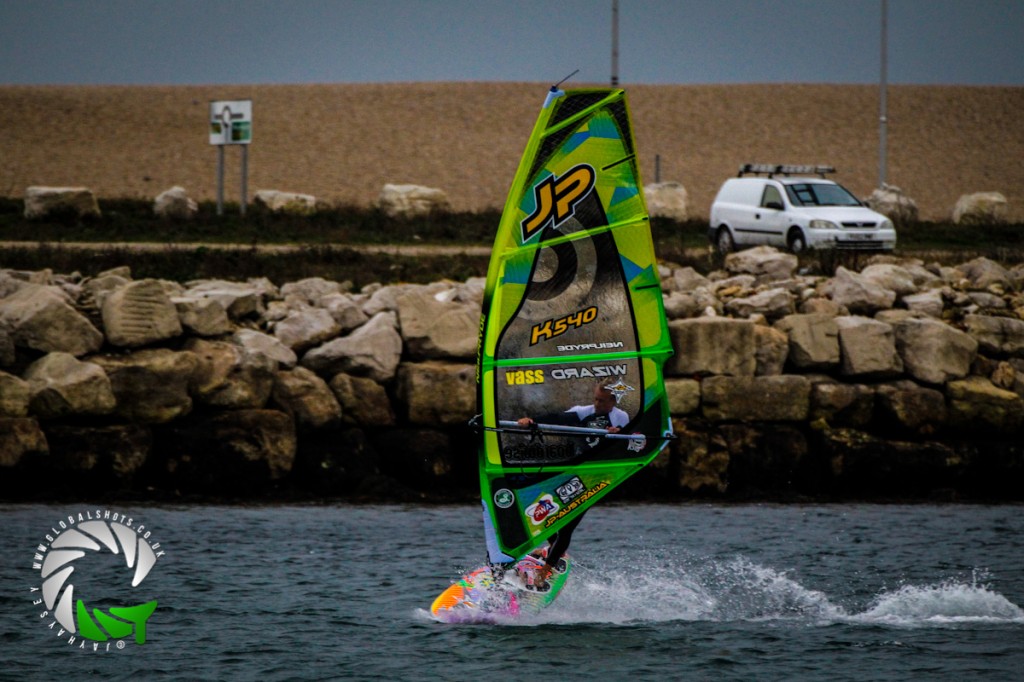
ANDY CHAMBERS: The top moves at the moment are being done all over the world. A lot of the PWA competitors compete on the EFPT and also a few of us compete on the UK circuit. The big move mainly are the combo moves like Spock into Culo or Burner into Funnel. Also some no handed power moves aswell. When the stunt ramps kick up like in Fuerte or Sylt then some of the older moves are being done fully in the air like double rotations, the ‘Pasko’ for example is an air flak into shaka.
JAMIE DRUMMOND: I didn’t do any of the UKWA events last year so can’t comment on the moves being done there. The move skill difference between the EFPT and PWA has narrowed slightly, but in the EFPT you are going to see a lot more moves per heat and this is due to the judging formats. The overall impression format means it helps to get down some Grubbies, Flakas, Spock and Forwards before smashing out a Burner or Skopu. Whereas the PWA Best Move format will see most heats being opened with Burners and Skopus and the more basic moves only performed if the wind is light.
How good do need to be to enter a UK amateur competition?
COLIN DIXON: Don’t do what I did and wait too long! Every time you enter a competition it will give you experience .
JO WRIGHT: Ladies – seriously, if you can duck gybe you will be well up there!
ADAM SIMS: There is competition at the events for any level, just head along and get involved. You’ll leave the event knowing what you need to practice for the next one.
JOHN PALMER: Come a long no matter how good you are! You will learn something!
MAX ROWE: The UK amateur competitions are a great way to improve as you’ll be pushed by people of a similar standard. Even if you’re not fussed about competing it’s a great way to learn a lot and also have a load of fun.
DANIELLE LUCAS: You should just be up for going out and trying your best! Even if you cannot yet land anything getting out with other freestylers to train, and have a laugh is really helpful in pushing you forward, inspiring you and showing you its worth the learning process!
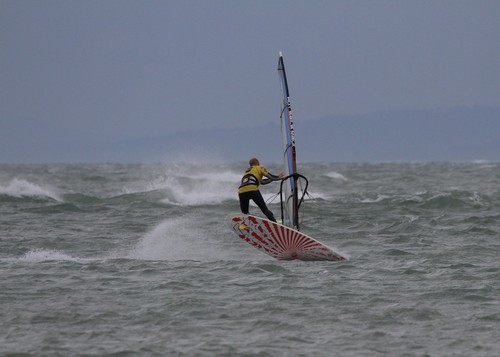
PHIL RICHARDS: Freestyle can be anything, from sailing along with one hand, to a heli-tack , a duck gybe, a jump, vulcans, flakas and much more. Ability is not so important, as we all realise that we all have to start somewhere.
As long as you turn up and give it a go, you might not win, however, you will learn lots from it and be inspired to improve.
ANDY CHAMBERS: If you can do any kind of freestyle then you will be welcome at any Uk event. The more events you attend then the more you will learn as well. There plenty of people and Pro’s around to give tips on moves and how to sail heats. As long as you can put a few moves together in a bit of a routine then you’re all good. A Vulcan with some old school freestyle thrown in will be fine.
What is the best approach going into a heat?
COLIN DIXON: With moves that you can do, not moves you can land one out of ten, All the guys I have coached in the past for competitions I have told them to build the points up first then try the moves you can only land now and again.
JO WRIGHT: With a big grin on your face!
ADAM SIMS: I think the best thing is to do something the I learnt from watching the ASP pro-surfing events, build a house (not literally). Start at the foundations, do the moves you know you will sail away from then add the bricks, the moves you can land but a bit less frequent, then finally if you do all that and have time, throw a roof on and bust out something you may have only landed a couple times. If you still have time then I find competition is a really good motivator for new moves…
JOHN PALMER: Look at it like a timed free sail, and try not to think about the other sailor.
MAX ROWE: You should just go out there thinking about having fun as you’ve got nothing to loose. That’s what I did and then from there you’ll learn about yourself and how you need to prepare. I’m really enjoying the commentating for the live stream on the PWA tour at the moment as I can just jump straight out of the box and on to the water without over thinking before.
DANIELLE LUCAS: Just go out and enjoy it, think about what you do best and try to get it done first, then try your other stuff once you have something in the bag! Also, try to stay upwind and in the area, this can take some getting used to in short heats! It depends on how the competition is being run as to an exact way to approach it, but best to just try to enjoy it and take it as something to learn from however it goes!

PHIL RICHARDS: Go out try what you know you can do consistently first, If that goes well try some of the more tricky stuff.
Try not to be nervous, and remember why you windsurf in the first place. Because it’s fun!
ANDY CHAMBERS: Main thing I think is to have fun with it and just go and sail like you would do normally for the allocated time. Don’t panic or watch the other person as this will make you loose time and get you flustered when you see them bust out something good. Sail your own heat and just concentrate on what your doing. The better you get at heat sailing the more you will understand what you need to do to win.
JAMIE DRUMMOND: Make sure you are powered up, make sure you are in the correct heat and make sure your watch is set to the right time! Give yourself plenty of time to get upwind before the heat starts – if you’re in position in plenty of time you’ll be a lot more confident going into the heat.
It’s always a good idea to start out with some of your more basic or ‘safe’ moves. I try to avoid watching my competitor and just focus on my own thing. Play to what the conditions offer. For example if you really want a double jumping move where a good patch of flat water is ideal, don’t force it in a choppy patch – us the chop to boost a higher air or power move.
Check out parts one to three of the Freestyle Secrets series in the Boards Technique section here.

